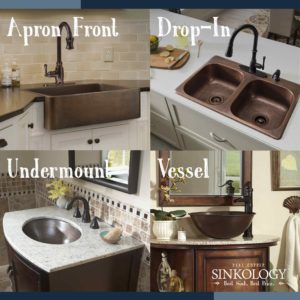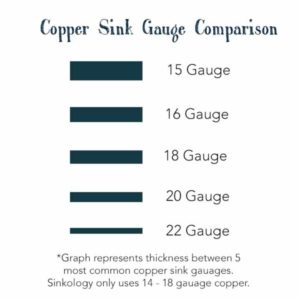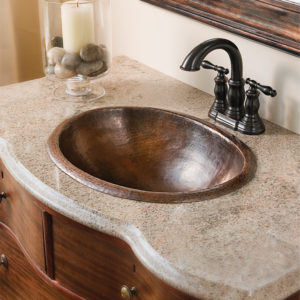The Sinkology Copper Sink Buying Guide
At Sinkology, copper sinks are our passion. So, we created this buying guide especially for our awesome customers and any one who is shopping for a new sink for their kitchen or bathroom. We encourage people to think differently about the design of their kitchen or bathroom by first choosing this ever-important centerpiece, and then designing their room outwardly from there.
Because the sink is used so often, it really should be the central design element in your room plan, and at Sinkology, we do our best to help make renovations as easy as possible. Our copper sink buying guide provides a detailed rundown of everything you need to know when deciding which copper sink to buy for your kitchen or bath, whether it ends up being copper or not. Although, we hope that it is copper. So, if you are wondering how to buy a copper sink; here are your answers.
Patina: A Little Background
Copper is an awesome, naturally occurring element. It’s durable, yet malleable. It’s beautiful and unique. It’s easy to maintain. It’s infinitely recyclable without compromising its structural integrity. In fact, 80% of the copper that has been mined from the earth and put in use is still in use today.
 We find it such an interesting and stunningly beautiful material because of all these characteristics; but, one of the coolest things about copper is the patina. Patina is a completely natural phenomenon that involves copper developing its own protective coating. The patina is usually deep, warm browns that will change and darken over time. Certain acidic or harsh items will strip the patina (a lime slice, a glob of toothpaste or ketchup, etc.) and return the copper to a bright shine, but the sink will self-heal and re-patina over time leaving your sink with a rich coppery blend of light and dark tones.
We find it such an interesting and stunningly beautiful material because of all these characteristics; but, one of the coolest things about copper is the patina. Patina is a completely natural phenomenon that involves copper developing its own protective coating. The patina is usually deep, warm browns that will change and darken over time. Certain acidic or harsh items will strip the patina (a lime slice, a glob of toothpaste or ketchup, etc.) and return the copper to a bright shine, but the sink will self-heal and re-patina over time leaving your sink with a rich coppery blend of light and dark tones.
Don’t worry, this doesn’t mean your sink will ever turn green. While green oxidation can appear on some copper, this is due to harsh environments (like weather and large shifts in temperature), salt water, and other factors that typically occur outdoors. If a copper sink is properly cleaned and cared for in your indoor kitchen or bathroom, green oxidation will never occur.
It’s important that when you are selecting a sink, you understand patina before committing to a copper sink for your kitchen or bath. Some people aren’t anticipating the natural coloration shifts that occur with patina and it can catch them off-guard. If you do select a copper sink and a stripping of the patina does occur, remember that it is completely normal. So, when it does happen, take a deep breath, sit back, relax and let the patina process take over.
Read about one customer’s experience here.
Finishes
While the patina will naturally shift throughout the years, there are a variety of different finishes when it comes to copper sinks.
 Aged – A warm vibrant finish, aged copper is brought to the point of an all-over patina through our exclusive aging process. This finish ensures durability and a more consistent appearance to your copper. It requires less up-keep than a naked finish. Aged copper is our most popular bath sink finish.
Aged – A warm vibrant finish, aged copper is brought to the point of an all-over patina through our exclusive aging process. This finish ensures durability and a more consistent appearance to your copper. It requires less up-keep than a naked finish. Aged copper is our most popular bath sink finish.- Antique – A medium to light tone, the antique copper finish is designed to reflect long-term care and use. Antique copper’s finish is hand-applied at our factories for the classic and timeless look. Antique copper is our most popular finish for kitchen and prep sinks.
- Naked – This is copper at its most raw and finest. Naked and natural, this non-finish allows you to choose your maintenance: let it age and patina naturally with minimal upkeep, or keep it shiny and polished with Copper Armor, available in our Copper CareIQ Kit, to maintain its gleam and luster.
- Verde – This copper finish is our most rare and exclusive. This finish was painstakingly mastered by our Sinkologists and artists to bring old world beauty to your home. It is usually applied to a naked copper interior.
Mounting Styles
As with sinks built with other materials, copper sinks span a variety of installation or mounting styles. Some overlap between a kitchen and a bath, while some are unique styles to each room. Through our years of copper sink design, we have focused on developing sinks that are, not only beautiful, but easy to install and functional; that’s why we offer broad and inclusive mounting styles.
- Drop-in – Whether a kitchen or a bath sink, a drop-in sink (sometimes
 called an overmount or self-rimmed) is designed to simply be dropped in to a pre-cut hole so the lip of the sink sits on top of the counter. This is typically the best choice for do-it-yourselfers, as it is a quick and easy way to update an existing kitchen or bath sink on a budget.
called an overmount or self-rimmed) is designed to simply be dropped in to a pre-cut hole so the lip of the sink sits on top of the counter. This is typically the best choice for do-it-yourselfers, as it is a quick and easy way to update an existing kitchen or bath sink on a budget. - Undermount – Also available for both a kitchen or a bathroom, the undermount sink mounts below the countertop. Edgeless and flexible, this mounting style offers a high-end look with easier cleaning and more space on your bathroom countertop.
- Vessel – This bathroom sink is typically a bowl-like design that sits on top of the countertop. This simple-to-install design adds a high-end feel to your bathroom and almost always is the centerpiece of the bath. At Sinkology, we include all of the necessary mounting hardware to make this installation type as simple as possible.
- Farmhouse – Also known as an apron front sink or farmer’s sink, this impressive sink is a classic design. Originally designed for ergonomics, it has a large copper front that eliminates the countertop between you and the sink causing less leaning and straining. This sink can either be undermounted or dropped-in.
- Dual-Flex – Sinkology also offers our exclusive Dual-Flex Rim on many of our copper sinks. This rim allows the sink to be installed as either a drop-in or an undermount, allowing for more versatility in your interior design.
Gauge
 Gauge is a measurement of thickness of the copper sink material. When it comes to gauge, the lower the number, the thicker the copper. At Sinkology, all of our copper sinks range from 14-18 gauge pure solid copper. We have specifically selected this range because it strikes the perfect balance between strength, durability, weight, function, and design. Before buying a copper sink, always make sure you ask about gauge. If the gauge is anything higher than 18, consider looking for a new option. Thinner sinks can cause a tinny sound when the faucet runs and will be more susceptible to dings and dents from things like pots and pans.
Gauge is a measurement of thickness of the copper sink material. When it comes to gauge, the lower the number, the thicker the copper. At Sinkology, all of our copper sinks range from 14-18 gauge pure solid copper. We have specifically selected this range because it strikes the perfect balance between strength, durability, weight, function, and design. Before buying a copper sink, always make sure you ask about gauge. If the gauge is anything higher than 18, consider looking for a new option. Thinner sinks can cause a tinny sound when the faucet runs and will be more susceptible to dings and dents from things like pots and pans.
Purity
Purity is hugely important when selecting a copper sink. At Sinkology, all of our sinks are 99.98% pure solid copper. Ensure that the copper sink you select doesn’t contain any filler products, but especially make sure it doesn’t contain any lead. Many sink companies offer recycled copper options. While this is positive for the environment, it is very difficult to control the purity of recycled copper. At Sinkology, our sinks are not made from recycled copper, but they are 100% recyclable.
Size
Copper sinks come in many shapes and sizes. Before purchasing, make sure you check the detailed specifications of the sink and verify that it can fit easily in your space. When measuring a sink, be sure to check length, width, and depth, but also drain size. When measuring drain size, ensure that you pick the right size but also the right finish to coordinate. Also, check to see what you need to cut. For vessel sinks, cutting the countertop only requires a small hole. Whereas with a apron front kitchen copper sink, you’ll need to not only cut the countertop, but potentially the cabinets if your existing set-up was built for other mounting styles.
Faucets
While copper faucets are not common, there are many options that can fit well with a copper sink. Consider finishes like brass or bronze, or sometimes even black. Some faucet finishes (like oil-rubbed bronze) aren’t standardized for color, so make sure that the faucet you buy matches the copper sink finish you select.
The most important aspect when selecting a faucet, however, is that you get the right size. It can be a little confusing because it’s different between bathroom sinks and kitchen sinks. Here are a few quick tips on picking faucets for the different rooms:
 Bathroom sinks – Measure the distance between the two furthest faucet holes. You should measure from the center of each hole. Faucets typically come in 4-inch and 8-in options. Also, if you are installing a vessel sink, make sure that the faucet is tall enough and provides enough clearance over the rim of the sink.
Bathroom sinks – Measure the distance between the two furthest faucet holes. You should measure from the center of each hole. Faucets typically come in 4-inch and 8-in options. Also, if you are installing a vessel sink, make sure that the faucet is tall enough and provides enough clearance over the rim of the sink.- Kitchen sinks – With a kitchen sink, it’s important that you count the various faucet holes and buy a faucet to match. Some faucets have the hot and cold levers and sprayer all in one faucet, while others are separated. Don’t forget that sometimes kitchen sinks could need holes for other items like soap dispensers, a separate sprayer, or a spout for filtered water.
Sinkology now offers our kitchen and bathroom copper sinks as part of kit that includes a faucet and several other accessories. Through a meticulous process, during which we vetted many faucets against a specific criteria, we found the perfect partner in Pfister. Sinkology and Pfister All-In-One kits are available through Home Depot. For more information, check out this blog post, the listing of our kitchen kits, or the listing of our bath kits.
Design
Because your sink is the most heavily used area of your kitchen or bathroom, we believe that the sink should be the first decision when planning a room, and that everything else should be planned around this central element. That will ensure that the hardware, cabinets, flooring, tiling, and everything else has balance and that your room has more natural focal points.
Beyond overall room design and mounting styles, you have many options when it comes to copper sink design elements. At Sinkology, we offer different patterns and features for our farmhouse kitchen sinks that are customized and made by hand for each individual order. We also offer different bowl designs for our drop-in and undermount sinks, and an ever-growing range of options for our vessel sinks.
Many people view copper sinks as a classic and rustic design element in a home. This is true of many designs, but at Sinkology we offer a wide range of options that can also enhance modern and contemporary homes as well. Many of our vessel sinks, sleek undermounts, or bar and prep sinks are designed specifically for contemporary tastes.
When designing a room around a copper sink, be sure to consider both your faucet finish and your cabinet hardware – which are two critical details for a truly standout kitchen or bath. There are many fun hardware options that will, not only, match copper, but can add a unique or playful flare to your room.
Additional Considerations
 There are a few more things to consider when selecting a copper sink for your kitchen or bathroom. While care and maintenance is not any more difficult than other types of sinks, you may want to consider waxing your sink. The beauty of copper is in its natural patina, but some would prefer a more constant look. The copper wax helps shield the copper finish from food and other chemicals that may cause spots and blemishes. If you choose to wax your sink, you should apply the wax when you first install it and at least once a month going forward. This is a very simple process of spraying on a copper wax and wiping it off. Sinkology offers a Copper Armor kit, which includes everything you’ll need for several months of maintenance.
There are a few more things to consider when selecting a copper sink for your kitchen or bathroom. While care and maintenance is not any more difficult than other types of sinks, you may want to consider waxing your sink. The beauty of copper is in its natural patina, but some would prefer a more constant look. The copper wax helps shield the copper finish from food and other chemicals that may cause spots and blemishes. If you choose to wax your sink, you should apply the wax when you first install it and at least once a month going forward. This is a very simple process of spraying on a copper wax and wiping it off. Sinkology offers a Copper Armor kit, which includes everything you’ll need for several months of maintenance.
At Sinkology, we think it’s important to purchase a copper sink from a company that stands behind its product. That’s why we offer a lifetime warranty on all of our sinks. We know you won’t need it, but just in case, it’s there.
If you have any additional questions during your search, our Sinkologists are here to help. Contact us or follow us on Facebook, Twitter, Pinterest, or Instagram for more helpful tips and design ideas.